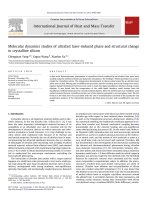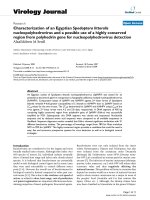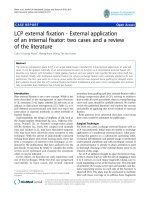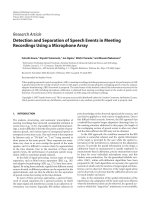Design of broadband vector sum phase shifters and a phased array demonstrator
Bạn đang xem bản rút gọn của tài liệu. Xem và tải ngay bản đầy đủ của tài liệu tại đây (4.12 MB, 78 trang )
DESIGN OF BROADBAND VECTOR-SUM PHASE
SHIFTERS AND A PHASED ARRAY DEMONSTRATOR
WINSON LIM
Bachelor of Engineering (Hons), NUS
A THESIS SUBMITTED
FOR THE DEGREE OF MASTER OF ENGINEERING
DEPARTMENT OF ELECTRICAL AND COMPUTER ENGINEERING
NATIONAL UNIVERSITY OF SINGAPORE
2013
DECLARATION
I hereby declare that the thesis is my original work and it has been written by me in its
entirety. I have duly acknowledged all the sources of information which have been used in
the thesis. This thesis has also not been submitted for any degree in any university
previously.
_________________
Winson Lim
7th September 2013
ii
Acknowledgements
I thank Dr. Koen Mouthaan and Dr. Tang Xinyi for their guidance in my research and the
MMIC lab for providing the facilities to carry out my research. I also thank my family for
their kind understanding to allow me to pursue my research studies.
iii
Table of Contents
Summary ........................................................................................................................................ vi
List of Tables................................................................................................................................. vii
List of Figures .............................................................................................................................. viii
Chapter 1 - Introduction .................................................................................................................. 1
1.1 Motivation ........................................................................................................................ 1
1.2 Thesis objectives .............................................................................................................. 5
1.3 Thesis organization .......................................................................................................... 5
1.4 List of publications ........................................................................................................... 6
Chapter 2 - Phase Shifters ............................................................................................................... 7
2.1 Introduction ...................................................................................................................... 7
2.2 Reflection type phase shifters .......................................................................................... 8
2.3 Switched network phase shifters ...................................................................................... 9
2.4 Loaded-line phase shifters.............................................................................................. 11
2.5 Vector sum phase shifter ................................................................................................ 13
2.5 Discussions..................................................................................................................... 14
Chapter 3 - Vector sum phase shifter ............................................................................................ 16
3.1 Introduction .................................................................................................................... 16
3.2 Literature review of vector sum phase shifter ................................................................ 17
3.3 Fundamental design of an I/Q network vector sum phase shifter .................................. 20
3.4 Proposed design and implementation of wideband VSPS at VHF band ....................... 21
3.1.1 Experimental setup ................................................................................................... 26
3.1.2 Experimental results ................................................................................................. 28
3.5 Conclusions and recommendations ................................................................................ 30
Chapter 4 - Vector sum phase shifter (L–Band design) ................................................................ 32
4.1 Introduction .................................................................................................................... 32
4.2 Proposed design and considerations at L-band .............................................................. 33
4.3 Modification of topology using simulation results ........................................................ 34
4.3.1 Experimental setup ................................................................................................... 37
iv
4.3.2 Experimental results ................................................................................................. 41
4.4 Conclusions and recommendations ................................................................................ 44
Chapter 5 - Phased array antenna system demonstrator................................................................ 46
5.1 Introduction .................................................................................................................... 46
5.2 Design and implementation of wideband phased array demonstrator ........................... 47
5.3 Experimental setup of the phased array demonstrator ................................................... 48
5.4 Experimental results of the phased array demonstrator ................................................. 52
5.5 Conclusions and recommendations ................................................................................ 54
Chapter 6 - Conclusions and Future Works .................................................................................. 56
6.1 Conclusions .................................................................................................................... 56
6.2 Recommendations .......................................................................................................... 59
References ..................................................................................................................................... 60
Appendix A: (VHF band) Datasheet information for COTS components used ........................... 63
Appendix B: (L band) Datasheet information for COTS components used ................................. 65
Appendix C: Datasheet information for patch antenna ................................................................. 67
Appendix D: Further readings ....................................................................................................... 69
v
Summary
Phased array antenna systems provide significant advantages and are used in
modern radar and wireless communication systems. Phase shifters are one of the key
components in electronically steered phased array antennas. There are a few phase shifter
topologies but the vector-sum phase shifter (VSPS) topology can generally provide a 360º
higher resolution performance.
Vector-sum phase shifters (VSPS) are usually narrowband and the phase and
amplitude error increase as the bandwidth widens. Designs have been explored to increase
the bandwidth of VSPS with low Root-Mean-Square (RMS) phase and amplitude error
using commercial-off-the-shelf components on printed circuit board (PCB). In addition,
other S-parameters like return losses, gain variation over frequency were also analyzed and
improved.
In this thesis, a wideband VHF VSPS has been designed for a bandwidth ratio of up
to 20:1 with desirable RMS phase error for a 3-bit phase shifter. The realized example
demonstrates a measured input return loss larger than 15 dB, amplitude imbalance less
than 1 dB and RMS phase error less than 1.5º from 10 to 100 MHz. For the wider
frequency range of 10 to 200 MHz, the measured input return loss is larger than 10 dB,
amplitude imbalance less than 2.5 dB and RMS phase error less than 5º.
Broadband L-band VSPS is then also designed to cover the entire L-band and also
improve on the S-parameters. Measured input and output return losses are larger than 18
dB and 25 dB respectively from 1 to 2 GHz. The gain variation is about 2 dB, amplitude
imbalance less than 1.5 dB and the RMS phase error less than 2.5º.
Lastly, a 4-element phased array demonstrator using the L-band VSPS has been
built and has successfully demonstrated beam steering capability at 1.8 GHz.
vi
List of Tables
Table I Performance comparison of phase shifters using discrete components on PCB .............. 31
Table II Performance comparison of phase shifters using discrete components on PCB ............. 45
vii
List of Figures
Figure 1-1: Basic scanning array architectures. (a) Linear passive array with phase shifters
for every element. (b) An active array with TRMs at every element (taken from [1]). .2
Figure 1-2: Active array systems architecture. ......................................................................3
Figure 2-1: Block diagram of a typical RTPS........................................................................8
Figure 2-2: Block diagram of a SNPS using difference in electrical lengths. .......................9
Figure 2-3: Block diagram of a SNPS using two networks. ................................................10
Figure 2-4: Third order high-pass/low-pass phase shifter....................................................10
Figure 2-5: Loaded line phase shifter [31]. ..........................................................................11
Figure 2-6: Bandwidth versus the phase shifts for different phase errors and return losses
of the lumped element loaded Class III phase shifters [31]. ........................................12
Figure 2-7: Block diagram of a typical VSPS. .....................................................................13
Figure 3-1: Block diagram of VSPS with base vectors generation network........................17
Figure 3-2: Vector sum phase shifter using polyphase filter network (taken from [48]). ...18
Figure 3-3: VSPS realizing 0º and 90º base vectors using APN (taken from [16]). ............19
Figure 3-4: Block diagram of a basic I/Q network vector sum phase shifter. .....................20
Figure 3-5: Proposed design of wideband VSPS. ................................................................21
Figure 3-6: Phase of simulated setup in ADS using ideal blocks. .......................................22
Figure 3-7: AD835 Analog multiplier connected as wideband VGA [Appendix A]. .........23
Figure 3-8: Amplitudes and polarities of 3 bit phase states. ................................................24
Figure 3-9: Simulated 3 bit phase shifts...............................................................................25
Figure 3-10: Simulated RMS phase error. ...........................................................................25
Figure 3-11: Photo of the fabricated phase shifter (8.4cm x 7.8cm)....................................26
Figure 3-12: Photo of the VSPS casing of 4 cm height. ......................................................27
Figure 3-13: Casing resonances using Sonnet: |
|. ..........................................................27
Figure 3-14: Measured input return loss. .............................................................................28
Figure 3-15: Measured phase shifts of 3 bit VSPS. .............................................................29
Figure 3-16: Measured insertion loss of fabricated phase shifter for 8 phase states............29
Figure 3-17: Simulated and measured RMS phase error. ....................................................30
viii
Figure 4-1: Proposed design of VSPS using analog multiplier circuits. ..............................32
Figure 4-2: Analog multiplier circuit (Topology 1). ............................................................33
Figure 4-3: Simulated S-parameters of VSPS (Topology 1). ..............................................34
Figure 4-4: Simulated RMS phase error of topologies 1 and 2............................................35
Figure 4-5: Modified voltage multiplier circuit (Topology 2). ............................................35
Figure 4-6: VSPS using analog multiplier circuit topology 2 and attenuator. .....................36
Figure 4-7: Simulated S-parameters (Topology 2). .............................................................36
Figure 4-8: Photo of the modular VSPS using ADL5391 evaluation boards. .....................37
Figure 4-9: Circuit of the fabricated VSPS. .........................................................................38
Figure 4-10: Fabricated PCB substrate for the VSPS (front side). ......................................39
Figure 4-11: Fabricated PCB substrate for the VSPS (back side). ......................................39
Figure 4-12: Photo of the fabricated phase shifter (6.4 cm x 4.3 cm)..................................40
Figure 4-13: Metallic casing of height 4 cm and lowest box resonance at 4250 MHz. .......41
Figure 4-14: Measured |S11| and |S22|. ..................................................................................42
Figure 4-15: Measured insertion loss of fabricated VSPS for all 8 phase states. ................42
Figure 4-16: Measured phase shifts of 3 bit VSPS. .............................................................43
Figure 4-17: Simulated and measured RMS phase error. ....................................................43
Figure 5-1: Beam steering of main-lobe towards the target of interest................................46
Figure 5-2: Block diagram of phased array demonstrator and the 360º VSPS. ...................48
Figure 5-3: Photo of the phased array demonstrator. ...........................................................49
Figure 5-4: Photo of the DAC AD5390 control of 8 analog voltages for beam steering. ...50
Figure 5-5: Radiation pattern and specifications of ZDAD17002500-8 [Appendix C].......50
Figure 5-6: Interior structure of the patch antenna...............................................................51
Figure 5-7: Photo of the array of patch antennas. ................................................................51
Figure 5-8: Experimental Setup for measurements. .............................................................52
Figure 5-9: Radiation beam pattern at progressive 0° phase shifts. .....................................53
Figure 5-10: Radiation beam pattern at progressive 45° phase shifts. .................................53
Figure 5-11: Radiation beam pattern at progressive 90° phase shifts. .................................54
ix
Chapter 1 - Introduction
1.1 Motivation
Beam scanning capabilities of phased array antennas provide significant system
advantages and thus are used by the military and industry in various modern radars and
wireless communication systems for space, airborne, surface and ground-based
applications. There are generally two types of phased arrays: passive and active phased
arrays. In passive phased arrays, antenna elements have a central transmitter/receiver (T/R)
and a power distribution network. There is generally no element amplitude control [1]. In
active phased arrays, each of the antenna elements or sub-arrays has its own T/R module
(TRM) and is able to provide complete flexibility in amplitude and phase control for both
transmit and receive. Another advantage of the active array is that the system sensitivity is
increased because the system noise figure is set and the RF power is generated at the
aperture. A second advantage of an active array is that the feed networks need not be
optimized for lowest loss; thereby allowing design flexibility and the ability to minimize
size (volume) and weight. Of course, these performance improvements come with
increased array complexity and cost. Thus comparing with passive arrays, active arrays can
provide added system capability and reliability but are generally more complex and
expensive.
As the technology of integrated circuits matures, it is now possible to integrate the
whole RF TRM into a single monolithic microwave integrated circuit (MMIC) which
reduces the cost of the active phased arrays [2], [3]. With the advent of technologies such
as CMOS and BiCMOS, reliable low-cost commercial-off-the-shelf (COTS) components,
automated assembly of microwave components, and low-cost high-speed high-throughput
1
digital-processors, active arrays systems are becoming the preferred option for many radar
systems and communication systems requiring rapid scanning [4], [5] shown in figure 1-2.
Figure 1-1: Basic scanning array architectures. (a) Linear passive array with phase shifters for every element.
(b) An active array with TRMs at every element (taken from [1]).
2
Figure 1-2: Active array systems architecture.
A phased array is an array of antenna elements spaced apart in one, two or three
dimensions to form the antenna beams in which the relative phases of the respective
signals feeding the antennas are varied in such a way that the effective radiation pattern of
the array is reinforced in a desired direction and suppressed in undesired directions [6].
Unlike conventional mechanically rotated antennas, the direction and the shape of the
antenna beam can be controlled electronically. By constructive or destructive combining of
the energy of each antenna element with different weight vectors, the antenna beams are
steered and shaped. The speed of beam steering and beam shaping is determined by the
switching speed of the circuits [7].
Another benefit of phased array antennas is the capability to simultaneously process
multiple functions at different frequencies [8]. To increase the functionality and capability of
the phased array antennas further, broadband performance is highly desirable. In active phased
array front-ends, possible fundamental control elements include attenuators and phase shifters.
Attenuators can achieve very broad bandwidths because they are resistive networks which are
frequency independent. However, insertion loss can be much higher if attenuators are used. As
for broadband phase shifters, they are more difficult to design. In addition, phase-shifter
3
critical design parameters include RF insertion loss, phase error, amplitude variation with
phase shift, switching times, power-handling capability, and the power required to shift the
phase. Also important are the size and weight of the phase shifter and its control circuits.
There is no one type of phase shifter that has desirable properties for all of these
parameters [9] and design research can be explored to improve on this.
As mentioned earlier, a key essential component of an active phased array antenna
is the phase shifter. To scan to an angle off boresight, a differential phase shift between
elements is required. It is convenient to quantize the 360 differential phase shift into
discrete increments. For example, a 5-bit phase shifter has phase increments of 11.25º. The
32 different phase increments can be realized by cascading five phase shifters with the
differential phase increments of 11.25º, 22.5º, 45º, 90º, and 180º and then switching each
differential phase shift bit in and out as appropriate to realize the desired beam steering
angle. Such digital phase shifters are most appropriate for active phased arrays because
they are controlled easily by a special-purpose digital computer (the beam-steering
controller). However, advanced precise phased array systems with a limited number of
elements and very low side lobes require phase shifters of high resolutions [10]. The high
phase resolution is very difficult to achieve with phase shifters, such as reflection type
phase shifters (RTPS) [11], [12], switched network phase shifters (SNPS) [13], [14], due to
accumulation of phase errors. The vector-sum phase shifter, which applies a variable and
adjustable phase shift to an arbitrary RF signal over a finite bandwidth, is able to provide a
phase shift of full 360° with high resolution at microwave frequencies since they have
excellent amplitude and phase balance over a wide bandwidth [15], [16]. Thus, research
can be done to improve the vector sum phase shifter to meet other desirable properties over
a wide bandwidth i.e. insertion loss and amplitude variation over a wide bandwidth.
4
1.2 Thesis objectives
The intention of this work is to explore the vector sum phase shifter topology to
design a low cost broadband phased array antenna system through the use of affordable
commercial-off-the-shelf (COTS) components.
Improvement of phase-shifter critical
design parameters of the phase shifter such as RMS phase error, RF insertion loss,
amplitude variation and insertion losses are explored in this work. The thesis is divided
into two parts. The first part consists of the study and analysis of broadband phase shifters
like the vector-sum phase shifter which allows high phase resolution with low RMS phase
errors. Such broadband vector-sum phase shifters are then designed and improved using
Agilent’s Advanced Design System (ADS) in two frequency bands namely the VHF band
and the L-band. The two designs are implemented using COTS components on printed
circuit boards. The second part demonstrates a 4-element phased array demonstrator using
the L-band vector-sum phase shifter. Beam steering capability is shown with easy control
through the use of a DAC which interfaces with a special-purpose digital computer (the
beam-steering controller).
1.3 Thesis organization
Following the introduction, chapter 2 discusses some of the basic topologies and
operation of phase shifters and their key differences. Chapter 3 introduces a literature
review of the vector sum phase shifter. The fundamental design of an I/Q network vector
sum phase shifter is also discussed. With the advent of high frequency analog multipliers,
the design of VSPS using analog multipliers for proper polarity and amplitude control is
introduced and the design has been implemented using COTS components on printed
circuit board (PCB) at both VHF band and L-band. The performance of the vector sum
phase shifters are tabulated in a table. A literature survey of phase-shifter critical design
parameters from the published papers is provided in the table to compare with the two
implemented designs. Chapter 4 introduces the elemental L–band vector sum phase shifter
5
and the 4-element phased array demonstrator setup. The beam steering controller of the
phased array demonstrator will be introduced which allows more precise and faster control
of the demonstrator. Anechoic chamber measurements of the beam steering capability of
the demonstrator are shown. Lastly, Chapter 5 summarizes the research and provides
recommendations for future work.
1.4 List of publications
Conference papers
W. Lim, X. Tang, K. Mouthaan, "L-band 360º vector-sum phase shifter using
COTS components," Microwave Conference Proceedings (APMC), 2012 AsiaPacific, pp. 100-102, 4-7 Dec. 2012.
W. Lim, X. Tang, K. Mouthaan, "A 10-200 MHz 360º vector-sum phase shifter
using COTS components for wideband phased array systems," International
Wireless Conference (IWC), 2013 Beijing, 13-18 Apr. 2013.
W. Lim, X. Tang, K. Mouthaan, "L-band 360º vector-sum phase shifter using
COTS components for 4-element phased array demonstrator," 3rd Sondra
Workshop, 2013 Hyères (France), 10-14 Jun. 2013.
6
Chapter 2 - Phase Shifters
2.1 Introduction
Phased array antenna systems provide beam steering capabilities. The three basic
electronic beam steering techniques are phase, frequency, and electronic feed switching. In
applications where wideband waveforms are required, phase steering is a preferred option.
Phase shifters are generally easier and less costly to implement than programmable true
time-delay elements.
An ideal phase shifter is a two-port device whose insertion phase can be changed
while its insertion loss remains the same. Assume the reference state has an insertion phase
of
, and the phase shifting state has an insertion phase of
, the phase shift is the phase
difference between the two states.
(2-1)
Generally for phase shifters with multiple phase states, the phase shift refers to the
phase change with respect to a reference phase state. In the following, four commonly used
types of phase shifter topologies are reviewed: reflection type phase shifters, switched
network phase shifters, loaded-line phase shifters, and vector-sum phase shifters.
7
2.2 Reflection type phase shifters
The reflection type phase shifter (RTPS) can be either digital or analog and some
ways of implementing the reflection network include using a four-port quadrature coupler
with two variable terminations. A simple reflection type phase shifter is shown in figure 21. An equal-split quadrature coupler divides the input signal into two signals 90º out of
phase. These signals reflect from a pair of switched loads and combine in phase at the
phase shift output as long as the loads are identical in reflection coefficient. Only one
control signal is required for such a phase shifter since the loads can be biased
simultaneously.
Figure 2-1: Block diagram of a typical RTPS.
The bandwidth of the reflection type phase shifter is determined by both the
coupler and the terminations. An example is demonstrated in [17] where broadband
terminations are used, but the slot fin-line coupler limits the bandwidth to 15% only. The
reported bandwidth using a branch line coupler is from 20% to 25% [18], [19]. Lange
couplers can provide a large bandwidth but the bandwidth of the phase shifter is then
limited by the terminations [12].
8
Broadband analog reflective phase shifters face the problem of achieving a large
phase shift range of 360º. Research has been done to increase the phase shift range for a
single section reflective phase shifter but the overall phase bandwidth will be reduced [20]
- [22].
2.3 Switched network phase shifters
A general switched network phase shifter (SNPS) is shown in figure 2-2. The
difference in the electrical lengths of the reference arm and the delay arm can easily be
computed for the phase shift. SPDT switches can be realized in a wide variety of ways
using FETs, diodes, or micro-electro-mechanical system switches. The insertion loss of a
switched network phase shifter is dominated by the switch losses.
Figure 2-2: Block diagram of a SNPS using difference in electrical lengths.
There are many developments in this type of phase shifter because of the numerous
ways to create a difference in phase between the two arms using different network
combinations. Instead of using general electrical lengths, different passbands of different
networks are used to obtain phase difference between the two arms as shown in figure 2-3.
One of the popular topologies for such networks phase shifters is the high-pass/low-pass
phase shifter.
9
Figure 2-3: Block diagram of a SNPS using two networks.
In [23], a bandwidth of nearly an octave is achieved and if more stages of highpass/low-pass networks are used, larger bandwidth can be realized. However, the circuit
area will increase and delicate tuning of the components in both arms is required. This is
due to the increased number of components like inductors and capacitors which have
variances in their performances.
Figure 2-4: Third order high-pass/low-pass phase shifter.
This topology also allows for large phase shift requirements. Examples using the
HP/LP circuits to provide the required phase difference include the TX-RX switches with
leakage cancelation [24] and the broadband multi-port direct receiver [25].
10
2.4 Loaded-line phase shifters
The concept of the loaded-line phase shifters is to use the loads to change the
electrical length of a fixed transmission line. And therefore, it is a transmission type phase
shifter. The topology is shown in Fig. 2-5.
Figure 2-5: Loaded line phase shifter [31].
The loads inserted at the two ends of the transmission line can be controlled
digitally to change the electrical length of the center line with impedance of
and
original electrical length of θ. In an analog phase shifter, the loads are controlled
continuously. However, the perfect matching condition may not be always met. Here we
are discussing a binary phase shifter with two possible load states:
loss of the loads is neglected, the insertion phase
changes to
. When the
(i=1, 2) can be obtained from [26]:
,
Therefore, when
and
i = 1, 2
(2-2)
, the phase shift can be obtained from (2-1). Based
on this prototype, the analysis for different loads and switching components are provided in
detail in [27]-[31]. Three different classes with nonzero and unequal loads (Class I), loadunload loads (Class II) and complex-conjugate loads (Class III) are concluded in [31]. It is
11
found that the loaded line phase shifter has the largest bandwidth and perfect matching at the
center frequency for Class III when the original electrical length of θ is around 90º. The design
parameters can be obtained from
(
)
( )
(2-3)
i = 1,2
(2-4)
This topology cannot be used for 180º phase shifters due to the extreme values
from (2-4). When the design parameters are obtained, the return loss and phase error can
be written as a function of the normalized frequency. Therefore, the return loss bandwidth
(
) and phase error bandwidth (
) are related to the phase shift values. The
relations for Class III loaded-line phase shifters with discrete loads are plotted in figure 2-6
for phase shift ranges from 5º to 120º.
Figure 2-6: Bandwidth versus the phase shifts for different phase errors and return losses of the lumped
element loaded Class III phase shifters [31].
From figure 2-6, the overall bandwidth of the loaded-line phase shifter is mainly
limited by the return loss when the required phase shift increases. For example, when the
12
phase shift is 90º, the 4º (±2º) phase error bandwidth
is 35% while the 15 dB
is 14%, and the overall bandwidth is limited to 14% when the required return loss is 15 dB.
The larger the phase shifts the smaller the bandwidth is. At 120º phase shift, the bandwidth
is at around 10 – 20%. This property does not allow the loaded-line phase shifter to
achieve 360º phase control with broad bandwidth.
2.5 Vector sum phase shifter
Figure 2-7: Block diagram of a typical VSPS.
The vector based phase shifter first generates base vectors, and then combines the
vectors with different amplitude weights to achieve different phase shifts. The concept is
shown in figure 2-7. There are various methods to realize the base vectors 0º and refº such
as using the quadrature coupler which results in 0º and 90º base vectors. Due to such
flexibility, the vector sum phase shifter has potential for a small circuit size. However,
these methods to realize the base vectors usually limit the bandwidth of the vector sum
phase shifter.
Some other considerations include the power consumption, power handling
capability, reciprocity and the linearity of the phase shifter because vector sum phase
shifters require variable gain amplifiers (VGAs) and digital-to-analog converters (DACs)
13
to control the weighting of the vectors which consume extra power as compared to
conventional phase shifter designs.
2.5 Discussions
Phase shifters are the most essential elements in electronic beam-steering systems
such as phased-array antennas. In the past, various phase shifter topologies were developed
with different emphasis: to minimize the circuit area, to maximize the operation bandwidth, to
minimize the insertion loss and its variation, etc. This chapter reviews four most important
phase shifters including the reflection type phase shifter, the switched network phase shifter,
the loaded-line phase shifter and the vector sum phase shifters.
The loaded-line phase shifter has the narrowest bandwidth while the other three types
can have comparable bandwidth. However, the loaded-line topology has promising
performance for millimeter wave implementations because of its simple structure.
There is high design flexibility in the switched network phase shifters as various types
of high-pass and low-pass networks can be used in the design. For low frequency designs, the
lumped elements can be used and for high frequency designs, the distributed networks can be
used. However to increase the bandwidth, higher order networks are required. This increases
the number of discrete components which increases the circuit size and intrinsic parameter
error which requires delicate tuning.
The reflection type phase shifter can achieve a large bandwidth if both the coupler and
the terminations have wide bandwidths. However, it is not a good option for low frequency
designs or extremely high frequency designs. For low frequency designs, the broadband
coupler consumes a large area. For high frequency design up to 80 GHz, the Lange coupler is
difficult to implement due to the extremely narrow lines required and the associated high loss.
Branch line couplers can be used for high frequency designs. However, the broadband
characteristics of the reflection type phase shifter are eliminated.
14
The vector sum phase shifter can be used for low frequency and high frequency
designs and may lead to very compact circuits. It can also provide continuous phase shifts over
wide operation bandwidths. However, the power consumption and the linearity should also be
considered as VGAs and DACs are required for the weighting of the base vectors.
15
Chapter 3 - Vector sum phase shifter
3.1 Introduction
Compared to passive designs, active phase shifters [32]–[39] in which phase shifts
are obtained by the role of transistors rather than passive networks, can achieve a high
integration level with decent gain and accuracy along with a fine digital phase control
under a constrained power budget. Although sometimes referred to differently as an
endless PS [32], a programmable PS [33], a Cartesian PS [35], or a phase rotator [36], the
underlying principle for all cases is similar and are thus categorized as vector-sum phase
shifters. The underlying principle is to weigh the phases of two input signals through
adding the base vector inputs for synthesizing the required phase. The different amplitude
weightings between the base vector inputs result in different phases. Thus, the basic
function blocks of a typical active phase shifter are composed of a base vectors generation
network, a power combiner, and control circuits which set the different amplitude
weightings of the base vectors in the power combiner for the necessary phase bits.
After the introduction, chapter 3 provides a literature review of the vector sum
phase shifter and the implementation of a wideband vector sum phase shifter at the VHF
frequency band using analog multipliers. A literature survey table is also provided on the
phase shifter performances from the past published papers as compared to the implemented
vector sum phase shifter.
16









